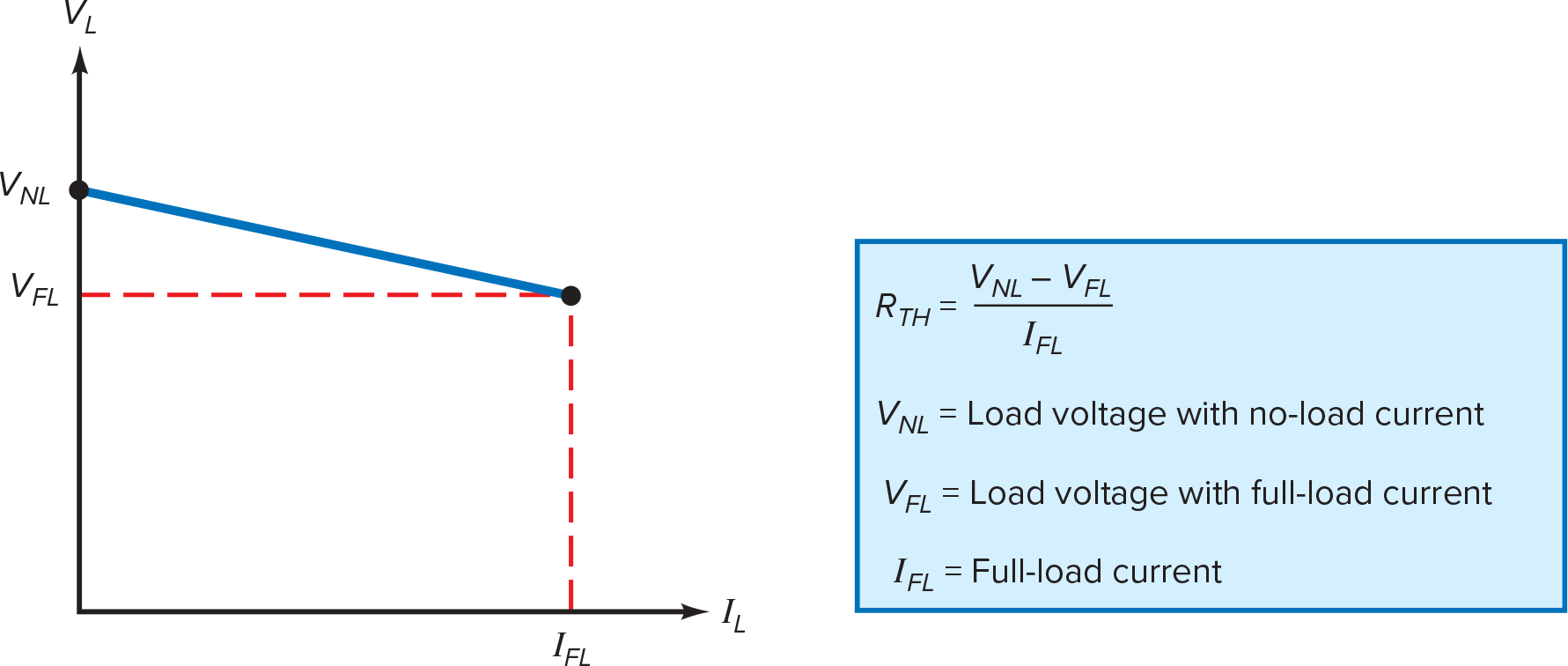The quality of a power supply depends on its load regulation, line regulation, and output resistance. In this section, we will look at these characteristics because they are often used on data sheets to specify power supplies.
Power Supply Load Regulation
Figure 1 shows a bridge rectifier with a capacitor-input filter. Changing the load resistance will change the load voltage. If we reduce the load resistance, we get more ripple and additional voltage drop across the transformer windings and diodes. Because of this, an increase in load current always decreases the load voltage.

Figure 1. Power supply with capacitor-input filter.
Load regulation indicates how much the load voltage changes when the load current changes. The definition of load regulation is:
$$Load\ Regulation=\ \frac{V_{NL}-V_{FL}}{V_{FL}}\times100\ (1)$$
Where,
VNL = load voltage with no-load current
VFL = load voltage with full-load current
With this definition, VNL occurs when the load current is zero, and VFL occurs when the load current is the maximum value for the design. For instance, suppose that the power supply of Figure 1 has these values:
$$V_{NL}=10.6\ V\ for\ I_L=0$$
$$V_{FL}=9.25\ V\ for\ I_L=1\ A$$
Then, Equation (1) gives:
$$Load\ Regulation=\ \frac{10.6-9.25}{9.25}\times100%=14.6%$$
The smaller the load regulation, the better the power supply. For instance, a well-regulated power supply can have a load regulation of less than 1 percent. This means that the load voltage varies less than 1 percent over the full range of load current.
Power Supply Line Regulation
In Figure 1, the input line voltage has a nominal value of 120V. The actual voltage coming out of a power outlet may vary from 105 to 125V rms, depending on the time of day, the locality, and other factors. Since the secondary voltage is directly proportional to the line voltage, the load voltage in Figure 1 will change when the line voltage changes.
Another way to specify the quality of a power supply is by its line regulation, defined as:
$$Line\ Regulation=\ \frac{V_{HL}-V_{LL}}{V_{LL}}\times100\ (2)$$
Where,
VHL = load voltage with high line
VLL = load voltage with low line
For instance, suppose that the power supply of Figure 1 has these measured values:
$$V_{LL}=9.2\ V\ for\ line\ voltage=105\ V_{rms}$$
$$V_{HL}=11.2\ V\ \ for\ line\ voltage=125\ V_{rms}$$
Then, Equation (2) gives:
$$Line\ Regulation=\ \frac{11.2-9.2}{9.2}\times100%=21.7%$$
As with load regulation, the smaller the line regulation, the better the power supply. For example, a well-regulated power supply can have a line regulation of less than 0.1 percent. This means that the load voltage varies less than 0.1 percent when the line voltage varies from 105 to 125 Vrms.
Power Supply Output Resistance
The Thevenin or output resistance of a power supply determines the load regulation. If a power supply has a low output resistance, its load regulation will also be low. Here is one way to calculate the output resistance:
$$R_{TH}=\ \frac{V_{NL}-V_{FL}}{I_{FL}}\ (3)$$
Good To Know
Equation (3) can also be shown as:
$$R_{TH}=\ \frac{V_{NL}-V_{FL}}{V_{FL}}\times\ R_L$$
For example, here are the values given earlier for Figure 1:
$$V_{NL}=10.6\ V\ for\ I_L=0$$
$$V_{FL}=9.25\ V\ for\ I_L=1\ A$$
For this power supply, the output resistance is:
$$R_{TH}=\ \frac{10.6-9.25}{1}\times100=135\Omega$$
Figure 2 shows a graph of load voltage versus load current. As we can see, the load voltage decreases when the load current increases. The change in load voltage (VNL – VFL) divided by the change in current VFL equals the output resistance of the power supply. The output resistance is related to the slope of this graph. The more horizontal the graph, the lower the output resistance.

Figure 2. Graph of load voltage versus load current in power supply.
In Figure 2, the maximum load current IFL occurs when the load resistance is minimum. Because of this, an equivalent expression for load regulation is:
$$Load\ Regulation=\ \frac{R_{TH}}{R_{L\left(min\right)}}\times100%$$
For example, if a power supply has an output resistance of 1.5 Ω and the minimum load resistance is 10 Ω, it has a load regulation of:
$$Load\ Regulation=\ \frac{1.5\Omega}{10\Omega}\times100%=15%$$
Power Supply Characteristics Key Takeaways
The characteristics of load regulation, line regulation, and output resistance are fundamental aspects of power supplies that profoundly impact their performance and reliability. Load regulation determines how much the output voltage changes with varying load currents, ensuring stable operation even under changing loads. Line regulation specifies how the output voltage varies with fluctuations in input voltage, crucial for maintaining consistent performance despite variations in the power grid. Additionally, output resistance, defined by Thevenin’s theorem, plays a critical role in load regulation, highlighting the relationship between load current and voltage stability. These characteristics, with load and line regulation, ideally minimized and output resistance optimized, are vital for ensuring power supplies deliver consistent and reliable performance across various applications in electronics and electrical systems.